Abstract
This paper demonstrates the global land degradation, impacting 40% of the population due to human activities and climate change. Unsustainable agriculture annually depletes 24 billion tons of fertile soil, heightening climate change. The study highlights consequences, disproportionately affecting 3.2 billion people, especially rural communities and smallholder farmers. With the projected global population at 9.7 billion by 2050, the demand for agricultural products strains already pressured land resources. Land degradation varies globally due to factors like unsustainable agriculture, deforestation, and climate change. In India, where 27.77% of land faced degradation in 2015-16, natural farming emerges as a sustainable solution, addressing soil health, biodiversity, and long-term food security. Climate change worsens challenges, causing crop failures, particularly in developing countries like India, impacting overall agricultural output. The overuse of chemical fertilizers significantly contributes to soil degradation. Natural farming is presented as a resilient alternative, emphasizing regenerative methods, reduced environmental impact, and climate resilience. Techniques like cover cropping, no-till farming, and reduced pesticide use positively impact soil structure and fertility. Economic benefits of natural farming, such as healthier soils, improved water cycles, and reduced pollution and operational costs, are highlighted. Initiatives in India, like the Network Project on Organic Farming and Zero Budget Natural Farming, promote income doubling and environmental benefits. Case studies showcase successful implementations, encouraging widespread adoption, supported by government initiatives and organizations like NITI Aayog. The transformative potential of natural farming is underscored, offering a sustainable and equitable future for global agriculture amidst challenges posed by land degradation, climate change, and chemical fertilizers.
Introduction
Earth’s vital land, crucial for human survival, deteriorates due to human activities and exacerbated by climate change. Lambin et al. (2013) and Willemen et al. (2020) stress severe impacts, jeopardizing 40% of the global population’s living conditions and forecasting a 10% cut in global economic output. Yengoh et al. (2016) reveal 24% land degradation from 1981 to 2003, with unsustainable agricultural practices annually losing 24 billion tons of fertile soil, contributing significantly to climate change (Eswaran et al., 2019). Land degradation caused 3.6–4.4 petagrams of CO2 emissions in the early 2000s, constituting 10–12% of global carbon emissions (UNCCD, 2019; Le Quere et al., 2018). Recent studies warn continuing unsustainable practices could degrade 95% of Earth’s land areas by 2050, impacting 3.2 billion people globally and disproportionately affecting rural communities, smallholder farmers, and the impoverished (Jiang et al., 2024; Hossain et al., 2020). With the global population expected to reach 9.7 billion by 2050, growing demand for agricultural products intensifies pressure on the land due to factors like biodiversity loss, climate variability, and extreme weather events (Duro et al., 2020). Climate change amplifies variations in agriculture, threatening agro-ecosystems and food production stability. Land degradation varies across continents, posing challenges in Europe, Central Asia, Africa, South America, and North America. Western Europe faces soil care challenges from urbanization and unsustainable agriculture (Hossain et al., 2020), while Eastern Europe, Russia, and Turkey shift to intensified agriculture, leading to fertile soil over-exploitation (European Commission (Press release) 2017). Central Asia, including Kazakhstan and Uzbekistan, experiences soil erosion and nutrient depletion due to unsustainable land and water management. In Africa, where 65% of global degraded lands are located, degradation results from inappropriate farming, deforestation, and conflicts affecting land tenure, with soil and water erosion impacting 80% of Africa’s soils, especially in the Sahel belt. South America experiences land degradation from water and wind erosion, acidification, and soil salinization, with notable challenges in Chile and Bolivia. In North America, soil degradation results from improper agriculture, livestock practices, and urbanization. Integrated techniques, like cover crops, address soil quality decline, but unsustainable land management practices remain significant contributors across regions (European Commission (Press release) 2017). Challenges are acute in arid regions, constituting 40% of global land and sustaining a population of two billion (Environment Management Group, 2011), with most impacts felt in developing nations, particularly among women and children. Rooted in agricultural activities, deforestation, and climate change, contributing factors include land clearance, soil nutrient depletion, livestock impact, inappropriate irrigation, and human activities like urban sprawl. Land degradation adversely affects food security, causing heightened insecurity, increased prices, and disruptions in agriculture. ISRO reported India’s land degradation at 91.30 million hectares in 2005–2006, slightly reducing to 91.21 million hectares in 2015–16, about 27.77% of the country’s total area, with Rajasthan, Maharashtra, and Jammu & Kashmir contributing over 40%.

Furthermore, rising temperatures, characterized by severe storms, prolonged droughts, and heavy rainfall, are jeopardizing vital global food crops. A 1°C temperature increase correlates with average global yield reductions of 6.0% for wheat, 3.2% for rice, 7.4% for maize, and 3.1% for soybean. Alarming projections from the IPCC warn that a 4°C temperature rise may lead to a 30% decline in rice production and a 70% drop in maize production in India. Scientific consensus attributes the surge in greenhouse gases to both natural and human-induced factors, intensifying the greenhouse effect and causing Earth’s atmosphere and surface to warm. This warming contributes to more frequent and severe climatic events, impacting agriculture, a highly vulnerable sector. While global climate change affects the entire world, its adverse effects vary based on countries’ adaptive capabilities. Developing countries, despite historical contributions, are more susceptible, with India’s agriculture facing heightened vulnerability due to limited adaptive capacity. This study examines climate change’s impact on major crop yields in India, anticipating substantial losses in agricultural productivity. IPCC predictions suggest a mean temperature increase of 1.1–6.4°C by the century’s end, potentially resulting in crop yield losses and overall agricultural output reductions ranging from 3–17% and 10–40%, respectively, by 2100.
In agriculture, inorganic fertilizers quickly provide essential nutrients to plants, contrasting with the slower release of organic counterparts. They meet plants’ immediate needs, promoting swift growth and aligning with farming requirements. Cost-effective and versatile, inorganic fertilizers enhance soil chemical properties, boosting macro and micro nutrient concentrations. Despite benefits, reliance on them can hinder optimal plant characteristics, reduce crop efficiency, and contribute to land degradation. Excessive nitrogen leads to crop issues, affecting quality and ecosystem balance. Savci (2012) warns of adverse effects, including discoloration, destruction, and reduced yields from overusing chemical fertilizers. Urgent action is needed to manage the intricate human-land relationship, striving for the crucial goal of land degradation neutrality amid a growing global population and changing climate. Natural farming offers a promising alternative, prioritizing soil health, biodiversity, and ecosystem resilience to mitigate land degradation and enhance long-term food security (Pavithra, 2023).
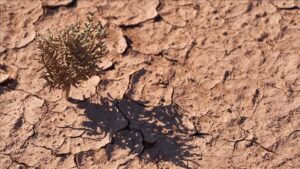
Natural Farming as a Resilient Solution
Amidst the grim challenges posed by climate change and land degradation, natural farming emerges as a resilient alternative. Its focus on soil health, reduced environmental impact, and climate resilience make it a valuable strategy in the face of climate change-induced disruptions in agriculture and address food security concerns. This approach, rooted in regenerative agricultural methods, seeks to minimize the use of external inputs, foster ecological balance, and enhance the overall sustainability of farming systems. Key components of natural farming include agroecological principles, organic farming methods, and the incorporation of traditional knowledge. Regenerative agriculture is also known as “agroecology” and “ecological farming”. Organic farming, permaculture and biodynamics are all examples of regenerative agriculture. Agroecological practices, such as crop diversification and integrated pest management, contribute to improved soil structure and fertility, reducing the reliance on synthetic inputs. Organic farming methods, which eschew synthetic pesticides and fertilizers, promote healthier ecosystems and minimize the environmental impact of agricultural practices (NRDC, 2021).
Practices involved in Natural Farming:
Cover cropping
The practice of planting crops in bare soil after the main cash crop is harvested. It prevents erosion, improves water retention, promotes soil health, increases biodiversity, and offers various benefits by keeping live roots in the soil. Cover crops can be planted during harvest or in between rows of permanent crops (NRDC, 2021). According to an analysis of yield data gathered from a nationwide survey on cover crops, farmers can anticipate a 3% rise in corn yield and a 4.9% increase in soybean yield following five consecutive years of cover crop implementation (Clark, 2015). Notably, during the drought year of 2012, farmers reported even more substantial yield gains with cover crop usage, experiencing a 9.6% increase in corn yield and an 11.6% boost in soybean yield (Clark, 2015).
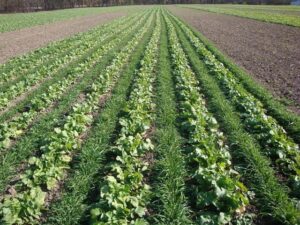
Holistically managed grazing, or intensive rotational grazing
It is an Indigenous practice that mimics natural grazing patterns. Livestock are moved between pastures regularly, improving soil fertility and allowing grass to regrow. (NRDC, 2021). The aim of grazing management is to 1. enhance land productivity and biodiversity by providing specific plant species with rest periods, 2. minimizing selective grazing by animals, 3. ensuring an even distribution of grazing pressure (Briske et al., 2008). Basically, there are two main ways animals’ graze: continuous grazing, where animals roam freely over an extended period in a larger area, and rotational grazing, where they are moved between different smaller areas. This sustainable approach supports healthier ecosystems and better land management (Nordborg, 2016). The perennial pastures promoted by Holistic Management (HM) practices have demonstrated an ability to hold more soil carbon, (Sanjari et al., 2008; Teague et al., 2011; Sherren et al 2012). This phenomenon contributes significantly to carbon sequestration.
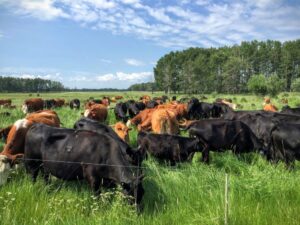
No-till farming
A method where farmers plant crops without digging or turning the soil. Instead of plowing, they leave the soil undisturbed (NRDC, 2021). There are three primary techniques for no-till farming. The first is known as “sod seeding,” where crops are planted using seeding machinery into a sod created by applying herbicides on a cover crop, essentially killing that vegetation. The second method is “direct seeding,” which involves planting crops through the residue of the previous crop. The third approach is “surface seeding” or “direct seeding,” where seeds are placed on the soil’s surface. On flatlands, this method requires no machinery and involves minimal labor (Willy, 2010).
Research from over 19 years of tillage studies conducted by the United States Department of Agriculture Agricultural Research Service found that no-till farming renders soil less prone to erosion compared to ploughed soil in Great Plains regions. Specifically, the first inch of no-till soil exhibits a higher concentration of aggregates and is found to be two to seven times less susceptible to erosion than its ploughed counterpart. The increased presence of organic matter in this layer is believed to play a crucial role in binding soil particles together, contributing to the enhanced erosion resistance observed in no-till farming practices (Blanco-Canqui, 2009).
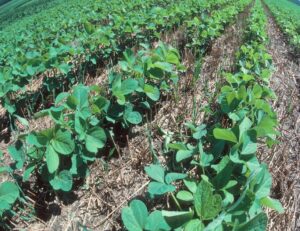
Composting
Composting is a natural process that transforms waste, such as manure or food scraps, into nutrient-rich fertilizer (NRDC, 2021). Composting organisms thrive with four equally vital components: Carbon serves as the energy source, with materials rich in carbon being brown and dry; Nitrogen is essential for the growth of organisms responsible for oxidizing carbon, found in green and moist materials like colorful fruits and vegetables; Oxygen is crucial for the oxidation of carbon, with aerobic bacteria requiring oxygen levels above 5%; Water, in the right proportions, sustains microbial activity without causing low-oxygen conditions, ensuring the overall effectiveness of the composting process (EPA, 2013; The Science of Composting, 2016).
The UNEP Food Waste Index highlights the global issue of 1.3 billion tonnes of annual food loss, exacerbated by the COVID-19 pandemic causing hunger for 811 million people in 2020. Food loss contributes to climate change, biodiversity loss, and pollution. UNEP and IGES endorse composting as an excellent method to manage organic waste and mitigate environmental impacts. Proper composting of daily organic waste reduces reliance on chemical fertilizers, enhances soil fertility, and improves water retention and nutrient delivery to plants. Additionally, reducing food waste through composting plays a vital role in lowering greenhouse gas emissions, estimated at 8-10% globally, and mitigating stress on biodiversity caused by the demand for land and water resources.
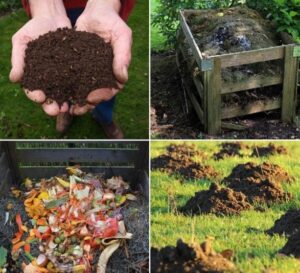
Reducing or eliminating the use of fossil fuel-based substances, like pesticides
Farmers strategically focus on improving soil health and implementing natural pest control techniques, prioritizing the cultivation of fertile and resilient soil. This approach minimizes the reliance on chemical treatments, irrespective of the pursuit of organic certification. The Food and Agriculture Organization (FAO, 2021) reports a continual global increase in pesticide use, exceeding 4.1 billion kilograms in 2018. This underscores the crucial need to explore alternative methods aimed at diminishing dependence on chemical pesticides.
Agroforestry
Agroforestry, inspired by forest ecosystems, involves the incorporation of trees and shrubs into farming practices, creating mini-forests on agricultural lands (NRDC, 2021). In this approach, the canopy of trees serves a pivotal role in mitigating soil erosion by intercepting rainfall, diminishing raindrop force, and reducing soil erosion potential (Kaushal et al., 2017). Furthermore, tree litter aids in the formation of water-stable aggregates, contributing to a decrease in surface runoff volume.
Three primary agroforestry systems exist (FAO, 2015): Agrisilvicultural systems combine crop cultivation with tree growth, as seen in alley cropping or homegardens. Silvopastoral systems integrate forestry with animal grazing, occurring in pastures, rangelands, or on-farm. Agrosylvopastoral systems integrate trees, animals, and crops, exemplified by homegardens incorporating scattered trees on croplands, often used for post-harvest grazing. McDonald et al. (2002) reported a significant reduction in soil erosion by 21 times and a sevenfold decrease in surface runoff compared to control soils in agroforestry practices. Agroforestry stands as a prominent tool for climate change mitigation, acknowledged in over 60 countries worldwide.
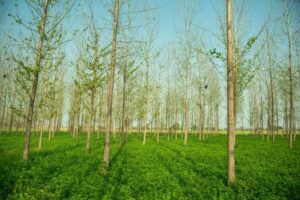
Conservation buffers, such as hedgerows and riparian buffers
Environmental concerns are addressed through the implementation of designated sections of land, each tailored to specific purposes. Hedgerows, comprised of rows of shrubs or trees surrounding fields, serve as a multifaceted solution. Biodiversity hedgerows incorporate native flowering plants and shrubs, attracting beneficial insects like pollinators and natural predators of pests, thereby enhancing biodiversity in agricultural landscapes and supporting ecosystem services. Windbreak hedgerows, planted with tall, dense trees in windy regions, protect crops from wind damage and reduce soil erosion. Wildlife corridor hedgerows are designed to connect fragmented habitats, facilitating the movement of animals between ecosystems, promoting genetic diversity, and ensuring overall ecological health (NRDC, 2021).
Riparian buffers, adjacent vegetated areas near streams, play a crucial role in environmental management. Along riverbanks, vegetated streambanks with native grasses, shrubs, and trees stabilize the soil, reduce erosion, and prevent sediment entry into the water. In agricultural landscapes, filter strips serve as riparian buffers between cropland and water bodies, trapping sediments and nutrients before reaching the water. Urban riparian buffers in urban areas, designed along streams or creeks with native vegetation, enhance water quality, provide habitat for urban wildlife, and improve the aesthetic appeal of the surroundings. Both hedgerows and riparian buffers integrate natural features into agricultural landscapes, promoting sustainability, biodiversity, and responsible land and water resource management.
 Figure 8 Hedgerow Figure 8 Hedgerow |
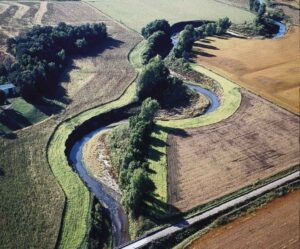 Figure 9 Riparian buffer Figure 9 Riparian buffer |
Environmental and Economic benefits of Natural agriculture:
Regenerative farming practices have demonstrated significant soil enhancements, resulting in healthier crops, augmented moisture levels, rich chocolate-colored soil, and vibrant microbial communities. These improvements contribute to the optimization of water, nutrient, and carbon cycles, fostering increased plant growth and overall soil health.
The reduction in chemical and pesticide usage by regenerative farmers not only leads to healthier soils but also plays a crucial role in mitigating environmental issues. This practice helps minimize harmful algal blooms, enhancing water quality and availability through pollution reduction. Moreover, the conservation of more water on the farm enhances resilience against both floods and droughts, contributing to sustainable agriculture. Harnessing the combined power of photosynthesis and microorganisms, soil becomes a potent carbon absorber, serving as Earth’s largest carbon storage. By adopting appropriate regenerative techniques, farmers can potentially draw down 250 million metric tons of CO2 equivalent greenhouse gases annually in the United States alone. This process holds the potential to reverse the adverse effects of climate change. The United Nations estimates that, by 2030, global soil carbon sequestration has the potential to mitigate around five gigatonnes of carbon per year, underscoring the significant role soil management can play in addressing climate change on a global scale.
Natural agricultural practices play a pivotal role in driving rural economic development, orchestrating a transition towards a more equitable agricultural economy. The foundation of this approach lies in strategic investments in processing facilities, value-added products, and food purchasing companies, which collectively empower farmers and elevate their share of revenue. The economic benefits stem from the enhancement of overall profitability, improvement in crop health, and the reduction of operational costs inherent to conventional agricultural methods. The systematic adoption of natural agricultural practices not only promotes economic inclusivity but also contributes to the resilience of farmers by facilitating more effective management of risks and debt.
The economic advantages of natural agricultural practices are underscored by the creation of a fairer and more sustainable economic ecosystem within rural communities. By prioritizing ecological principles, such as soil health and biodiversity, natural agriculture aligns with sustainable economic development goals. Challenges inherent to this transition exist, but regenerative farmers actively engage in addressing these impediments, driving the evolution towards a more equitable and economically viable agricultural system. Through a holistic lens, the economic benefits of natural agricultural practices manifest as a transformative force, fostering rural economic growth, sustainability, and the empowerment of farming communities.
Promoting Natural Agricultural Practices in India: Initiatives and Programs
The Indian Council of Agricultural Research (ICAR), based in New Delhi, initiated the Network Project on Organic Farming (NPOF) in the fiscal year 2004-05, designating the Indian Institute for Farming Systems Research (IIFSR) as the nodal institute. Launched during the 10th five-year plan, the NPOF absorbed the National Project on Development and Use of Biofertilisers under the Ministry of Agriculture, Government of India. The NPOF aims to promote organic farming practices, reduce reliance on chemical fertilizers, and optimize farm resource utilization. It provides financial and technical support for organic input production units, emphasizing market waste compost, biofertilizers, biopesticides, and vermicompost hatcheries. Implemented through the Department of Agriculture & Cooperation (DAC), Ministry of Agriculture, and the National Centre of Organic Farming (NCOF) in Ghaziabad, the NPOF facilitates financial assistance based on recommendations from a Screening Committee under the NCOF Director. Credit-linked back-ended subsidies for production units are supported through commercial/scheduled banks and NABARD. The Capital Investment Subsidy Scheme (CISS) aids municipalities, APMCs, companies, and entrepreneurs in establishing organic inputs production. The NPOF promotes various organic inputs, such as four bio-fertilizers (Rhizobium, Azotobacter, Azospirillum, and PSB) and two organic fertilizers (City Waste Compost and Vermi-compost). The scheme has resulted in processing capacities for 708 tons of agricultural waste daily, 5606 MT of bio-fertilizers, and over 17000 tons of vermiculture and vermicompost. Since inception, certified organic farming area expanded from 42,000 hectares in 2003-04 to 865,000 hectares in 2007-08, accompanied by a significant increase in organic food production from 4.09 lakh tons in 2006-07 to 9.02 lakh tons in 2007-08.
Zero Budget Natural Farming (ZBNF) is an agricultural approach advocating the cultivation of crops without external inputs like fertilizers and pesticides, resulting in zero production costs. Introduced by agriculturist Padmashri Subhash Palekar in the mid-1990s, ZBNF emphasizes sustainable practices, soil fertility preservation, and chemical-free agriculture to enhance farmers’ income. Core principles include excluding external inputs, using local seeds, microbial seed treatment, applying microbial inoculants, cover cropping, and integrating trees and livestock. ZBNF’s polycrop model combines short and long-duration crops, aiming to recover main crop costs from short-duration crop income, achieving zero expenditure. Key elements include Bijamrita (seed treatment), Jiwamrita (soil fertility revival), Mulching (topsoil cover), and Waaphasa (soil aeration). ZBNF addresses financial strain on farmers highlighted by National Sample Survey Office (NSSO) data, offering a solution by reducing production costs and breaking the debt cycle. Government initiatives like Paramparagat Krishi Vikas Yojana (PKVY) and Rashtriya Krishi Vikas Yojana (RKVY) support ZBNF. Benefits include cost reduction, environmental friendliness, sustainable farming, and potential income doubling by 2022. ZBNF aligns with environmentally conscious agriculture, and Andhra Pradesh aims to be the first state practicing 100% natural farming by 2024, supported by the Union Finance Minister’s acknowledgment of ZBNF’s potential in income doubling efforts.
Case Studies
NITI Aayog, in its commitment to promoting natural farming, recognizes the importance of substantiating and validating these practices. The organization has taken proactive measures to initiate research activities in this regard. This compilation aims to document and gather the exemplary practices employed by farmers across diverse regions in India, forming a compendium of success stories in natural farming. The stories of success come from sources such as Krishi Vigyan Kendras (KVK) all over India. Notably, farmers have come up with their own techniques and approaches to implement the tenets of natural farming, incorporating elements like Farm Yard Manure (FYM), vermicompost, etc. Their endeavors extend to embracing multi-cropping, encompassing the cultivation of cereals, pulses, vegetables, fruits, medicinal plants, and flowers, all in alignment with the principles of natural farming (Patel et al., 2022).
Table 1 Crops cultivated through natural farming (Patel et al., 2022).
| Sl. No | States | No. of farmers | Crops |
| 1 | Andhra Pradesh | 21 | Vegetables, Citrus, Red gram, Paddy, Black rice, Maize, Ragi, Ground nut |
| 2 | Bihar | 3 | Wheat, Paddy, Rapeseed, Potato |
| 3 | Gujarat | 13 | Banana, Falsa, Papaya, Groundnut, Mixed
Vegetables, Mixed Fruits Paddy, Wheat, Coconut & Groundnut, Chilli, Beetroot |
| 4 | Haryana | 7 | Wheat, Rice, Sugarcane, Lemon, Banana,
Pomegranate, Apple, Vegetables, Root crops, Marigold, Chick pea |
| 5 | Himachal Pradesh | 14 | Apple with Cereals & Vegetables, Vegetables,
Turmeric, Maize, Apple & Pea, Sugarcane, Sunflower, Urad |
| 6 | Kerala | 5 | Exotic vegetables, Rice, Turmeric, Orchid, Tubers |
| 7 | Madhya Pradesh | 3 | Mango, Coriander, Mustard, Gram, Wheat, Green
gram, Black gram, Turmeric, Fruits and Vegetable |
| 8 | Maharashtra | 8 | Sugarcane, Soyabean, Paddy, Ground nut, Wheat,
Onion, Vegetables, BT Cotton, Sorghum |
| 9 | Odisha | 4 | Indigenous Aromatic Paddy, Black rice, Red rice,
Vegetables, Red gram, Green gram, Finger millet |
| 10 | Punjab | 5 | Rice, Wheat, Pear, Vegetables, Flowers |
| 11 | Rajasthan | 11 | Cluster bean, Mung bean, Wheat, Chickpea, Mustard, Kinnow, Fenugreek, Maize, Henna, Sesame |
| 12 | Uttar Pradesh | 14 | Paddy, Scented Rice, Wheat, Sugarcane, Papaya
& Ground Nut, Mango, Aonla, Mosambi, Brahmi, Moringa, Wheat+Pea+Gram+Sun flower, Mustard+ Pea, Millets, Mint + Green gram |
| 13 | Uttarakhand | 2 | Wheat |
| Total | 100 |
Most farmers have reported that switching to natural farming methods has significantly lowered their cultivation costs while enhancing the quality and quantity of their produce. This shift has also led to higher prices for the naturally grown products. Farmers have emphasized noticeable improvements in both their own health and that of consumers, attributing it to the cultivation and consumption of chemical-free, natural products. The goal of compiling these best practices is to raise awareness about the benefits and actual methods of natural farming, encouraging widespread adoption across the country (Patel et al., 2022).
Conclusion
In conclusion, this paper examines the critical nexus of land degradation, climate change, and agricultural practices impacting global food security. It highlights the pressing need for immediate and strategic interventions to address the interconnected challenges of unsustainable farming, deforestation, and climate variability, leading to the degradation of Earth’s land. Projected outcomes signal the urgency to safeguard 3.2 billion people, especially in rural and impoverished regions, from potential severe consequences. Natural farming is a resilient alternative to conventional agriculture, proposing practices like cover cropping, holistic grazing, no-till farming, composting, reduced fossil fuel use, agroforestry, and conservation buffers. These practices offer a promising route to achieving land degradation neutrality, with outlined benefits such as enhanced soil health, reduced environmental impact, and economic inclusivity. The Indian context showcases initiatives like the Network Project on Organic Farming and Zero Budget Natural Farming, promoting natural farming practices and reducing reliance on chemical inputs. Case studies from various Indian states demonstrate tangible improvements in crop yields, economic viability, and environmental sustainability through natural farming. In essence, the paper advocates urgent global action to transition toward sustainable and regenerative agricultural practices, emphasizing the transformative potential of natural farming. The insights presented contribute to the evolving knowledge on sustainable agriculture, providing guidance for policymakers, researchers, and farmers to collaboratively address the intricate challenges of land degradation and climate change.
References
- Blanco-Canqui, H., Mikha, M. M., Benjamin, J. G., Stone, L. R., Schlegel, A. J., Lyon, D. J., … & Stahlman, P. W. (2009). Regional study of no‐till impacts on near‐surface aggregate properties that influence soil erodibility. Soil Science Society of America Journal, 73(4), 1361-1368.
- Briske, D. D., Derner, J. D., Brown, J. R., Fuhlendorf, S. D., Teague, W. R., Havstad, K. M., … & Willms, W. D. (2008). Rotational grazing on rangelands: reconciliation of perception and experimental evidence. Rangeland Ecology & Management, 61(1), 3-17.
- Clark A., 2015. Cover Crops for Sustainable Crop Rotations. SARE. Sustainable Agriculture Research and Education. https://www.sare.org/resources/cover-crops/
- Composting At Home. Reduce, Reuse, Recycle. 2013. US Environmental Protection Agency. https://www.epa.gov/recycle/composting-home.
- Duro, J. A., Lauk, C., Kastner, T., Erb, K. H., & Haberl, H. (2020). Global inequalities in food consumption, cropland demand and land-use efficiency: A decomposition analysis. Global Environmental Change, 64, 102124.
- Environment Management Group. 2011. Global Drylands: A UN system-wide response. https://unemg.org/2018/images/emgdocs/publications/Global_Drylands_Full_Report.pdf
- Eswaran, H., Lal, R., & Reich, P. F. (2019). Land degradation: an overview. Response to land degradation, 20-35.
- European Commission (Press release) (2017) No region left behind: launch of the platform for coal regions in transition. https://europa.eu/rapid/press-release_IP-17-5165_en.htm
- 2015. Agroforestry. Food and Agriculture Organization of the United Nations. https://www.fao.org/forestry/agroforestry/80338/en/
- 2021. How composting can reduce our impact on the planet. United Nations Environmental Programme (UNEP). https://www.unep.org/news-and-stories/story/how-composting-can-reduce-our-impact-planet
- Hossain, A., Krupnik, T. J., Timsina, J., Mahboob, M. G., Chaki, A. K., Farooq, M., …& Hasanuzzaman, M. (2020). Agricultural land degradation: processes and problems undermining future food security. In Environment, climate, plant and vegetation growth(pp. 17-61). Cham: Springer International Publishing.
- Jiang, K., Teuling, A. J., Chen, X., Huang, N., Wang, J., Zhang, Z., … & Pan, Z. (2024). Global land degradation hotspots based on multiple methods and indicators. Ecological Indicators, 158, 111462.
- Kaushal, R., Kumar, A., Alam, N. M., Mandal, D., Jayaparkash, J., Tomar, J. M. S., … & Mishra, P. K. (2017). Effect of different canopy management practices on rainfall partitioning in Morus alba. Ecological Engineering, 102, 374-380.
- Lambin, E. F., Gibbs, H. K., Ferreira, L., Grau, R., Mayaux, P., Meyfroidt, P., … & Munger, J. (2013). Estimating the world’s potentially available cropland using a bottom-up approach. Global environmental change, 23(5), 892-901.
- Le Quéré, C., Andrew, R. M., Friedlingstein, P., Sitch, S., Hauck, J., Pongratz, J., … & Zaehle, S. (2018). Global carbon budget 2018. Earth System Science Data Discussions, 2018, 1-3.
- McDonald, M. A., Healey, J. R., & Stevens, P. A. (2002). The effects of secondary forest clearance and subsequent land-use on erosion losses and soil properties in the Blue Mountains of Jamaica. Agriculture, Ecosystems & Environment, 92(1), 1-19.
- Nordborg, M. (2016). Holistic management–a critical review of Allan Savory’s grazing method.
- NRDC, 2021. Regenerative Agriculture 101. Natural Resources Defense Council. https://www.nrdc.org/stories/regenerative-agriculture-101.
- Patel, N., S. Athira., Sethi, T., Meena, S. 2022. Compendium of Success Stories of Natural Farming. NITI Aayog.
- Pavithra, K. M. 2023. Data: Total Extent of Land Degradation in India over 90 Million Hectares. FAQTLY. https://factly.in/data-total-extent-of-land-degradation-in-india-over-90-million-hectares/
- Sanjari, G., Ghadiri, H., Ciesiolka, C. A., & Yu, B. (2008). Comparing the effects of continuous and time-controlled grazing systems on soil characteristics in Southeast Queensland. Soil Research, 46(4), 348-358.
- Savci, S. (2012). An agricultural pollutant: chemical fertilizer. International Journal of Environmental Science and Development, 3(1), 73.
- Sherren, K., Fischer, J., & Fazey, I. (2012). Managing the grazing landscape: Insights for agricultural adaptation from a mid-drought photo-elicitation study in the Australian sheep-wheat belt. Agricultural systems, 106(1), 72-83.
- Teague, W. R., Dowhower, S. L., Baker, S. A., Haile, N., DeLaune, P. B., & Conover, D. M. (2011). Grazing management impacts on vegetation, soil biota and soil chemical, physical and hydrological properties in tall grass prairie. Agriculture, ecosystems & environment, 141(3-4), 310-322.
- The Science of Composting. 2016. Composting for the Homeowner. University of Illinois. https://web.archive.org/web/20160217221013/http://web.extension.illinois.edu/homecompost/science.cfm
- UNCCD, 2019. United Nations Convention to Combat Desertification – Land in Numbers 2019. Risks and Opportunities. UNCCD secretariat, Bonn, Germany.
- Willemen, L., Barger, N. N., Brink, B. T., Cantele, M., Erasmus, B. F., Fisher, J. L., … & Scholes, R. (2020). How to halt the global decline of lands. Nature Sustainability, 3(3), 164-166.
- Willy H. Verheye, ed. (2010). “Soil Engineering and Technology”. Soils, Plant Growth and Crop Production Volume I. EOLSS Publishers. p. 161. ISBN 978-1-84826-367-3.
- Yengoh, G. T., Dent, D., Olsson, L., Tengberg, A. E., Tucker III, C. J., Yengoh, G. T., … & Tucker, C. J. (2016). Development of Land Degradation Assessments. Use of the Normalized Difference Vegetation Index (NDVI) to Assess Land Degradation at Multiple Scales: Current Status, Future Trends, and Practical Considerations, 37-39.


